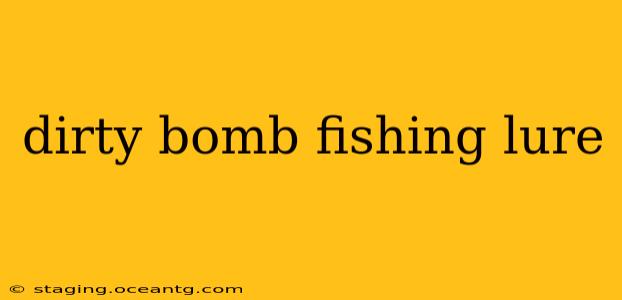The term "dirty bomb fishing lure" immediately grabs attention, conjuring images of something dangerous and intriguing. While the name is undeniably provocative, it's crucial to understand that it refers to a specific type of fishing lure, not a weapon. This article will explore the lure's design, effectiveness, and the reasons behind its controversial moniker. We'll also address some common questions surrounding this unique fishing tool.
What is a Dirty Bomb Fishing Lure?
A "dirty bomb" fishing lure is a type of jig designed to mimic injured or distressed baitfish. It typically features a bulky, often brightly colored, head that creates a lot of disturbance in the water. This disturbance, combined with the lure's erratic movement, is intended to attract predatory fish. The "dirty" aspect often refers to the use of multiple colors, flashy finishes, or even the inclusion of additional components like rattles or flashers designed to further enhance its visual and auditory appeal. The "bomb" part alludes to its aggressive, attention-grabbing nature. Think of it as a chaotic explosion of color and movement underwater.
How Effective is a Dirty Bomb Fishing Lure?
The effectiveness of a dirty bomb lure varies depending on several factors, including water clarity, target species, and fishing conditions. In murky or stained water, its vibrant colors and erratic action can be highly effective in attracting predatory fish that rely heavily on vibration and visual cues. However, in crystal-clear water, its exaggerated movements may make it appear unnatural and less appealing to discerning fish. Experimentation with different retrieve techniques is crucial to maximize its potential. Different retrieves, from slow rolling to fast jigs, can significantly impact its effectiveness.
What Types of Fish Does it Attract?
Dirty bomb lures are known to be particularly effective for attracting a wide range of predatory fish, including:
- Bass: Largemouth, smallmouth, and spotted bass are all known to readily strike at dirty bomb lures.
- Pike: The aggressive nature of the lure aligns well with the predatory instincts of pike.
- Muskie: Similar to pike, muskie are often drawn to the loud and flashy action of these lures.
- Striped Bass: In certain conditions, dirty bomb lures can be successful in enticing striped bass.
Are Dirty Bomb Lures Legal?
Yes, dirty bomb lures are completely legal to use in most fishing locations. The name is purely descriptive and does not implicate any illegal activity. However, always ensure you are adhering to all local fishing regulations, including size and bag limits, as well as any restrictions on the type of lures allowed in specific areas.
What are Some Alternatives to Dirty Bomb Lures?
While dirty bomb lures are popular, there are other effective alternatives that might suit your needs and fishing style better. Consider experimenting with:
- Spinnerbaits: These lures offer a similar flash and vibration.
- Buzzbaits: Excellent for topwater action and attracting aggressive strikes.
- Jigging Spoons: Create an erratic, attractive action underwater.
Why is the Name "Dirty Bomb" Controversial?
The name's controversial nature stems from its association with the term "dirty bomb," a radiological weapon. This stark contrast to its innocent application in fishing makes it a uniquely memorable – and potentially off-putting – name for some anglers.
In conclusion, while the name "dirty bomb fishing lure" is undeniably provocative, it ultimately refers to a type of fishing lure designed to create a chaotic and attention-grabbing underwater display. Its effectiveness is dependent on several factors, but its unique design makes it a popular choice among anglers targeting certain predatory species. Remember to always check your local fishing regulations before heading out.
